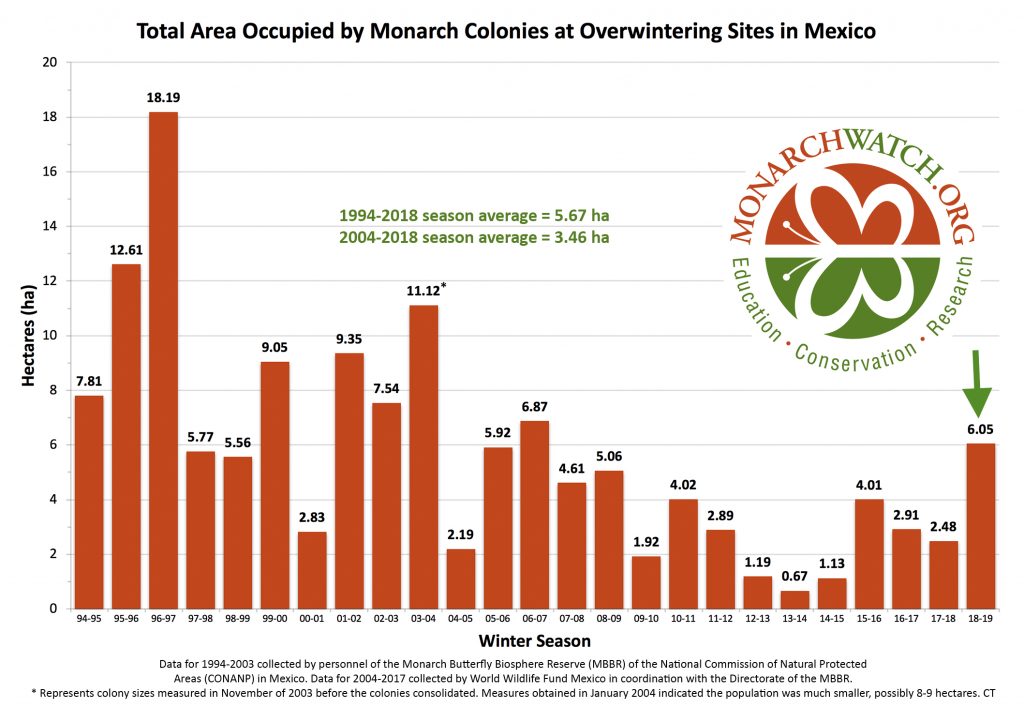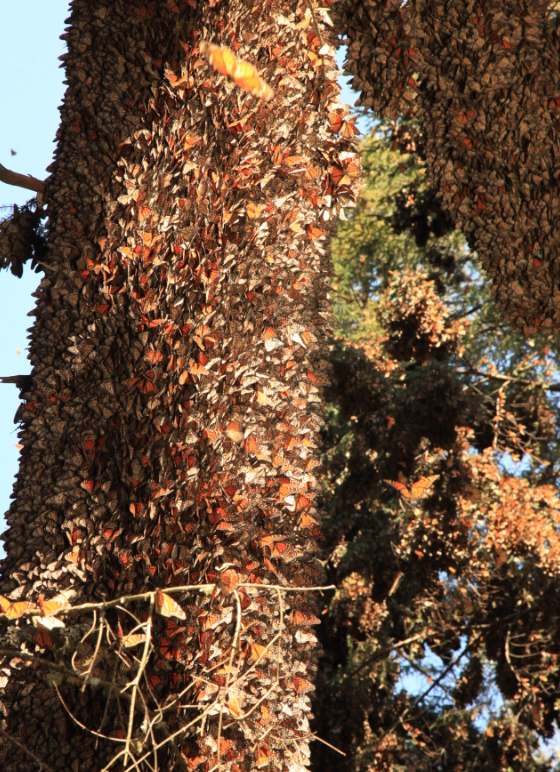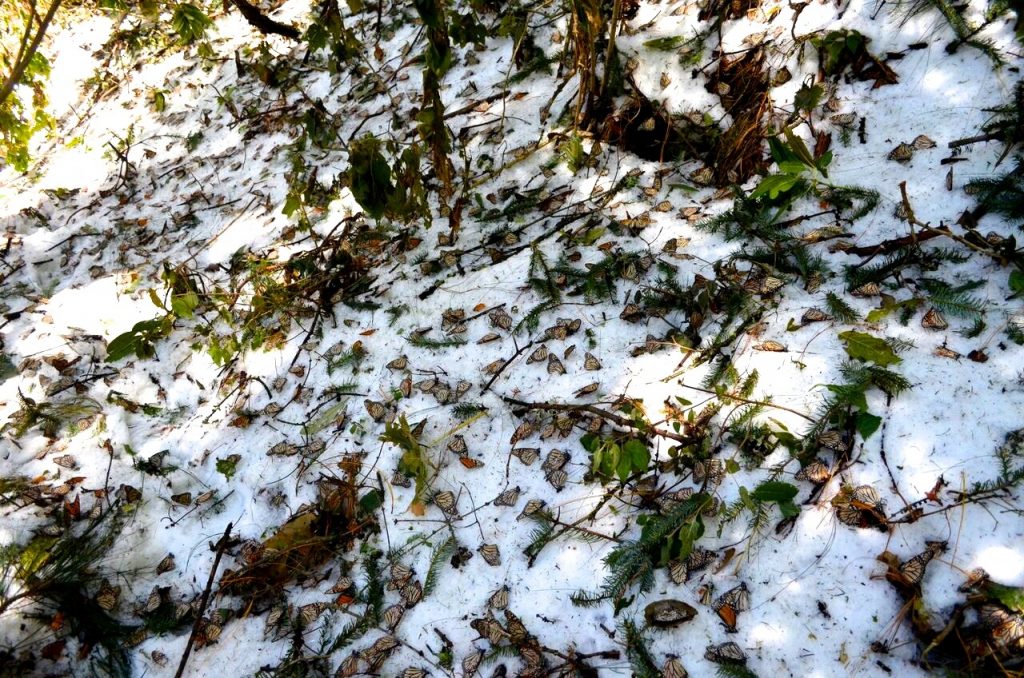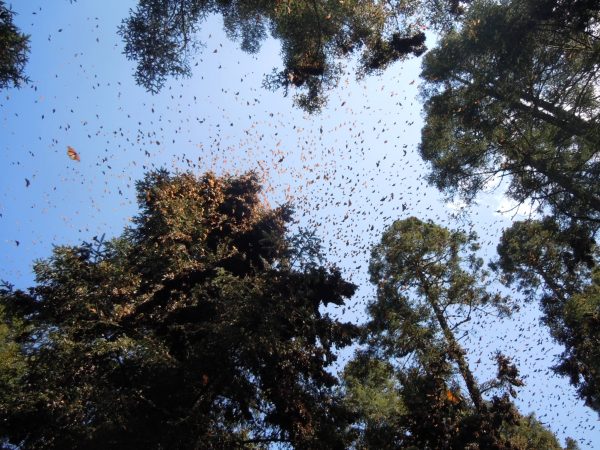The population of monarch butterflies that overwinter in Mexico has jumped more than 144% over last year, Mexican officials announced today.
The butterflies occupied 6.05 hectares (about 15 acres) of the high altitude Mexican forests this year, up from 2.48 hectares (about six acres) in early 2018. Such a large population has not been witnessed since 2006.

Representatives of the National Commission of Natural Protected Areas (CONANP) and the World Wildlife Fund-Telmex Telcel Foundation hailed the increase in population at a Mexico City press conference this morning. Read the press release here.
The officials noted that 14 colonies had been identified: eight colonies (4.98 hectares/12 acres) within the Monarch Butterfly Biosphere Reserve and six (1.07 hectares/2.6 acres) outside the preserve. For the first time, a colony was registered in the Ojo de Agua community, located in Nevado de Toluca, about 65 miles southeast of the preserves.
In the Monarch Butterfly Reserve, the largest of the 14 colonies was the popular and accessible El Rosario (Sierra Campanario sanctuary). It represented 40% of the total at 2.46 hectares (about six acres). Monarchs occupied .01 hectares (.02 acres) at the smallest colony, Contepec (Cerro Altamirano sanctuary). Both colonies are in the state of Michoacán.

Monarch butterflies cluster on Oyamel Trees in Michoacán–Photo courtesy SK Films
Counting monarch butterflies is an inexact science at best and calls have been made by scientists and others to improve the way we calculate the migrating population. Currently, technicians and scientists walk the forest and map the trees occupied by monarchs at each roost. They measure the perimeter of each colony, then calculate the number of hectares occupied. They then multiply the number of hectares by a factor of 20 million.
Using that formula, which has vacillated between 10 and 50 million over the years, the 2018-2019 population represents an estimated 121 million butterflies. The 2017 -2018 season was estimated at about 50 million using the same formula.
Jorge Rickards, managing director of WWF Mexico, attributed the increase to pollinator friendly initiatives throughout the trinational migratory path, favorable conditions in Texas, and generally favorable climate throughout the breeding zone.
Andrew Rhodes, director of Mexico’s National Commission of Natural Protected Areas, pointed out that butterfly populations fluctuate wildly and cautioned that “it’s important to not lower our guard in addressing threats such as climate change, land use, and changes and forest degradation.”
The good news was not unexpected. Several scientists had been predicting a banner year for the migrating insects.
Chip Taylor of Monarch Watch was optimistic as early as last July, writing on the Monarch Watch blog that “the migration should be the strongest since 2008.” He later encouraged visitors to go see the roosting sites this year, since “a population of this size may not occur again for another decade, and perhaps never.”

The scene at Chincua two weeks after the February 2017 storm. Photo by Dr. Isabel Ramíro
Threats still loom, however. Even in a year with a big rebound like this one, a freak freeze like the one that occurred in February 2017, could wipe out all progress.
In the meantime, 2019 has the potential to be an exceptional year for wildflowers in South Texas, typically the first stop for migrating monarchs. While it’s too early to predict, above average rains this winter suggest a likelihood of a strong wildflower showing with plenty of milkweed and nectar sources for early arrivals.
Related posts:
- Monarch butterfly population up in Mexico, down in California
- Monarch butterfly population drops 27%, freak sleet storm to blame
- Weird, late migration finally reaches Mexico
- Banner year for monarch butterfly migration? Texas Hill Country ready
- Five monarch butterflies tagged at Monarch Festival in San Antonio make it to Mexico
- How to Tag a Monarch Butterfly in Six Easy Steps
- What does climate change mean for Monarch butterflies?
- New study: late season nectar plants more important than milkweed to Monarch migration
- Monarch butterflies head north as Mexican scientists try to move their forest
Like what you’re reading? Follow butterfly and native plant news at the Texas Butterfly Ranch. Sign up for email delivery in the righthand navigation bar of this page, like us on Facebook, or follow us on Twitter, @monikam.


Fabulous, Monika! Keeping positive thoughts that the weather cooperates. ❤️
Great day ! Great Article ! I’m much more optimistic than Chip. It’s a crap shoot and
You’re right there’s a lot of factors.,
If we get through the winter without incident and get them to a blooming Texas we have the biggest population to send to the summer breeding grounds in over 10 years.
If it just rains in the Midwest normally this season the billions of shouts naturally sent out by existing plants in 2018 will flourish this coming season A hundred thousand enthsiasts will be protected rearing at least 50 monarchs this year helping some.
A lot of the predators were drown with the record rain last year. Remember, monarchs never touch the ground. With just normal rains in my new home in the summer breeding grounds in the Northeast sector and the of course Ill visit family in Iowa and make sure they’re rearing, I will go out on a limb and bet on at least 10 hectares next season and I hope I’m being conservative.
Thank you, Lord, and to those who help our endangered friends.🙏🦋🙏
When do Monarchs pass thru Central Florida?